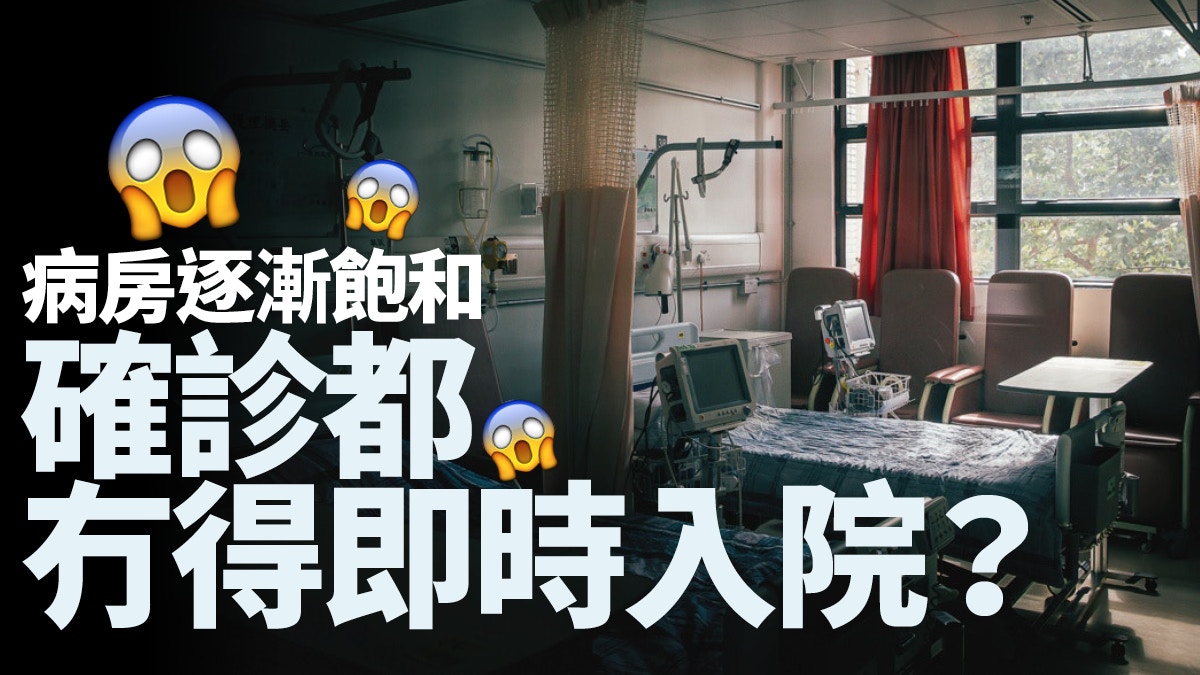01 perspective
Written by: Comment Editor
2020-03-31 13:40
Last updated: 2020-03-31 13:42The number of newly diagnosed patients with new coronary pneumonia (COVID-19) has skyrocketed, and hospital isolation beds are overwhelmed. A resident of the mortuary confirmed on Saturday (28th) was not admitted to Tuen Mun Hospital until noon this Monday (30th). There are also returning international students from confirmed to admission, waiting more than 24 hours. This not only increases the risk of community epidemic prevention, but also is not conducive to the treatment of confirmed patients. How to arrange for those who have not been admitted to the hospital and how to allocate isolated beds is a major challenge for the authorities.
On January 8, at the beginning of the outbreak, the Chief Secretary for Administration, Zhang Jianzong, proposed that the number of quarantine beds could be increased to 1,400 within 72 hours if necessary. However, on March 3, Li Xiayin, director of strategic development of the Hospital Authority, said that due to the hospital reconstruction plan, Only increased to 1,272 beds. As of Monday, Liu Jiaxian, the chief administrative manager of the Hospital Authority, said that 1,012 negative-pressure beds have been used, with a occupancy rate of 65%. Among them, 820 beds are in the medical ward, mainly receiving confirmed or suspected confirmed adults; another 66 are in Intensive care unit with 126 beds in the pediatric ward. Due to fear of cross-infection and other factors, most of the suspected and confirmed cases of new pneumonia are single people occupying a single room, so that the saturation rate of isolation wards is higher than that of beds, and some patients need to wait for admission. Coupled with the longer check-in period of patients diagnosed with new pneumonia, usually 17 to 20 days, and the isolation beds need to be thoroughly cleaned and disinfected, resulting in a low turnover rate of isolation beds, and more patients need to stay in the community.
The Hospital Authority said that the isolation beds were nearly full, and the general ward was being converted into a second-line isolation ward, hoping to increase the capacity of the ward to respond to the epidemic. (Profile picture / photo by Zhang Haowei).
According to the Center for Health Protection, 51 confirmed patients were not sent to the hospital on Sunday (29th), and 39 confirmed patients stayed in the community on Monday, waiting to be admitted. In this regard, the Hospital Authority has decided to use the 400 beds that were converted a month ago as "second-line isolation wards". The original purpose of the "Second Line Isolation Ward" was to divert patients and suspected cases to make more efficient use of the isolation beds.
First-line and second-line isolation wards
The "Second Line Isolation Ward" is a negative pressure isolation ward that is converted from an ordinary ward to a place where air can only enter. Its negative pressure specifications and medical staff's equipment, such as N95 respirator, full-face mask, gloves and protective clothing, are no different from the first-line ward, that is, the original negative pressure ward. However, the second-line isolation ward may concentrate two or three patients in one room, while the current first-line isolation ward only has one person in more than one room.
In the case of a large number of people and a small number of beds, the current practice of allocating all suspected, mildly diagnosed, severely diagnosed, etc. in the first-line isolation ward is obviously inefficient. Therefore, the second-line isolation ward will be responsible for diverting some of the mildly ill patients, the stable patients who are recovering, and the adult patients who are recovering, so as to reduce the impact of detained patients in the community. However, it is foreseeable that the inflection point has not yet reached. With the recent outbreak in Hong Kong, about 400 new beds will soon be exhausted. Due to the special nature of the isolation ward, it is not a temporary matter to expand or modify it.
The Central Committee on Infectious Diseases and Emergency Response met on March 30 to discuss guidelines for moving to a second-line isolation ward, including no fever for more than 48 hours, no more than 10 days of symptoms, no symptoms of respiratory infections and diarrhea, no need for oxygen, blood Testing has progressed.
The isolation ward was almost full. (Profile picture)
Between hospitalization and home
Therefore, the HA urgently needs new responses to deal with the growing number of confirmed patients. Some experts believe that patients can go home and be isolated. CUHK's Chair Professor of Respiratory Medicine Xu Shuchang pointed out that if the second-line isolation beds added by the Hospital Authority are also full, consideration should be given to relaxing the discharge criteria. If you do not need to be negative for two consecutive tests, you can be discharged, and the virus test is still positive Mild and stable patients go home for isolation. Yuan Guoyong, a professor in the Department of Microbiology at the University of Hong Kong, also holds a similar view. He is worried about 2,000 local cases at any time in Hong Kong. At that time, patients with mild symptoms are recommended to go home and isolate after the viral load is reduced to reduce the medical load.
However, Liang Zichao, chairman of the Medical Association's Advisory Committee on Infectious Diseases, did not agree with the patients' isolation. He believes that returning positive patients to the community poses an outbreak risk to the patient's family and the community, and "falls past efforts to isolate patients into the saltwater sea." He Bailiang, director of the University of Hong Kong's Infection and Infectious Diseases Center, also believes that even if the patient is stable, the virus is still present and it is dangerous to enter the community.
There is no third way between hospitalization and home. Citizens' Legislative Councillors Guo Jiaqi and Liang Zichao have suggested that they can follow the example of other countries and regions to build a "square cabin hospital", so that patients who are recovering are isolated there, and they do not return home until two negative virus tests. Insufficiency and the risk of patients staying in the community. "Fangcai Hospital" first appeared in Wuhan. At the time of the worst epidemic situation, a number of cabin hospitals were built in accordance with the existing buildings to concentrate the isolation of patients with mild and rehabilitation. Due to the fast and convenient construction of the square cabin hospital, countries such as Italy, Spain, the United Kingdom, Russia, and Iran subsequently adopted this method when the hospital was overwhelmed.
Many countries choose to build a square cabin hospital when the epidemic is severe, and relieve the pressure of general hospitals. (Associated Press)
Buying a bed from a private hospital?
For Hong Kong, Wan Chai Convention Center, Asia Expo Center and other places can be used as temporary square cabin hospital land. But what is more worth discussing is which patients are suitable for the square cabin hospital. In China, the United Kingdom, Spain, etc., the square cabin hospital is mainly used to treat patients with new-type pneumonia in mild or rehabilitation, which is equivalent to the role of a second-line isolation ward in Hong Kong. In the United States, the square cabin hospital built in the Expo Center is mainly used to treat other patients with mild chronic diseases, such as diabetes and hypertension. After all, the square cabin hospital is not as effective as a hospital in terms of isolation, and the corresponding medical equipment is not complete. The Government must take into account the social and medical environment of Hong Kong, learn from each other's strengths, and study early on the feasibility, location and planning of the cabins in case of emergency.
In addition to square cabin hospitals, the government should also consider buying beds from private hospitals to transfer low-risk, recovering patients to private hospitals for treatment. However, this will inevitably affect the operation of private hospitals. Therefore, how to subsidize, centralize one hospital or purchase from multiple private hospitals, etc., are all details that need to be conceived in advance.
Obviously, with the global outbreak of new coronary pneumonia, the end of the epidemic in the short term will never be possible. What's more, Yuan Guoyong said that the current situation is "somewhat out of control", and the government should make the worst preparations as soon as possible so that it can be prepared. Only in this way can Hong Kong avoid becoming the next Wuhan in this global epidemic.
[New Crown Pneumonia] Government wants private doctors to "reassured" diagnosis
[New crown pneumonia] Hong Kong people should self-segregate when epidemic or community outbreak hits
01 depth
New Crown Pneumonia Public Hospital Hospital Authority 01 Viewpoint












/cloudfront-eu-central-1.images.arcpublishing.com/prisa/KMEYMJKESBAZBE4MRBAM4TGHIQ.jpg)


